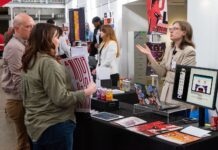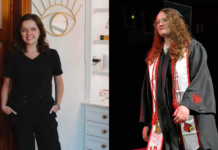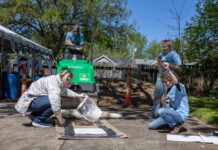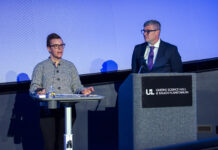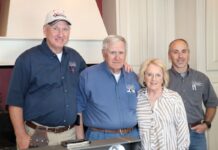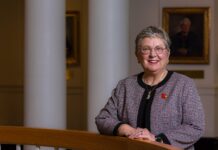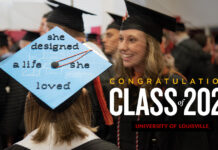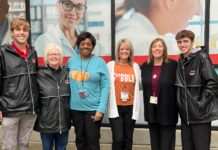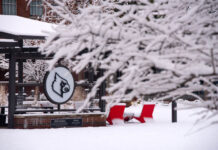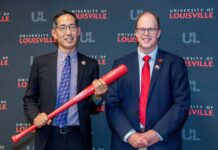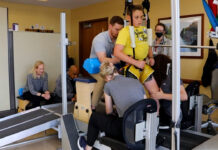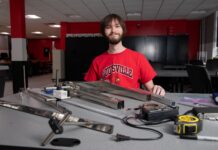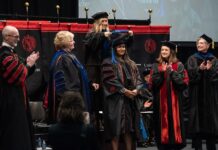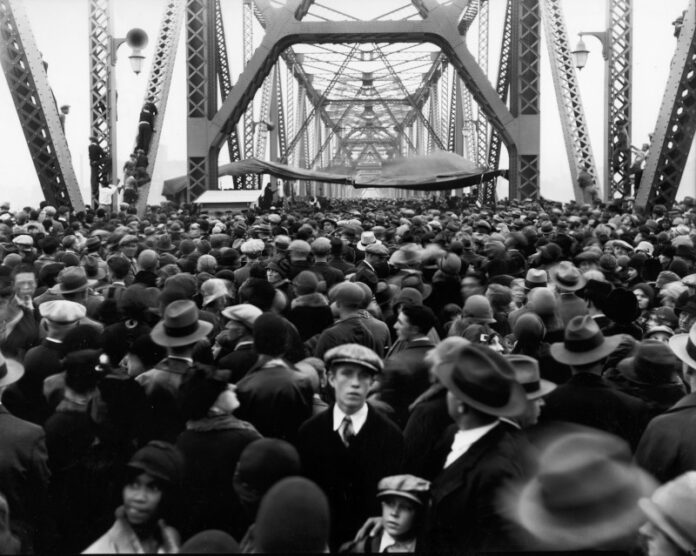
A picture is worth a thousand words. It’s a commonly used expression, maybe even a bit cliché. But for the University of Louisville Archives & Special Collections’ Elizabeth Reilly, it’s the truth.
“I often consider photographs as documents that you can read,” said Reilly, an associate professor and curator of UofL’s photographic archives. “What we can learn from old photographs, or photographs in general, is immense. And the preservation of that material is important for maintaining that information and being able to learn the history of our university, city and neighbors.”
A city comes into focus
The university’s archives include a trove of unique collections – each filled with countless artifacts. Reilly suspects that if you tallied the individual negatives, slides and prints from the photographic archives, UofL likely houses roughly 7-8 million images. But one collection in particular stands out – the Caufield & Shook collection.
“The Caufield & Shook collection is special because it’s all Louisville. It contains a lot of Louisville’s history and really documents the city’s growth,” Reilly said. “It’s a visual history, so a lot of people can truly connect to it and find photographs of their family, their businesses, houses, neighborhoods and streets. It’s one of our most-accessed collections.”
With a motto of “We photograph ANYTHING, day or night,” James Caufield and Frank W. Shook’s studio operated in Louisville, Kentucky, from 1903-1978. The bulk of the photographs are from the era after the Great Flood of 1937 that destroyed much of the studio’s earlier prints, although UofL does have some pre-flood material from work stored on the second story of Caufield & Shook’s Fourth Street studio.
A community collection
UofL’s photographic archives were founded in 1962, “which is pretty early for a university photo collection,” Reilly said. The university quickly gained attention as a place where photographs could be preserved and made available for research. This reputation made UofL an ideal guardian for Caufield & Shook, which began sending pieces from its studio archives to the university around 1968. UofL continued receiving batches until the studio shuttered in 1978.
Today, the library has digitized over 8,000 of those images, which are viewable through the Caufield & Shook digital collection. But they aren’t exclusively available to the university community – they’re for everybody.
“Anybody can come in and talk to one of our archivists or librarians who are sitting at our reference desk and say, ‘This is what I’m looking for, can you help me?’ We’re here for the community,” Reilly said.
Throughout the year, Reilly collaborates with professors and local educators to teach one-off sessions about specific topics they’re teaching in the classroom. She particularly finds excitement in introducing young Jefferson County Public School students to UofL’s collections, especially 3D images from the 19th century viewed through a stereo viewer.
Preserve, organize, describe
As archivists, Reilly and her colleagues receive and process collections, craft descriptions to make them discoverable, and then make them available to the public. Preservation as an act is a labor-intensive process and relies on a myriad of resources from climate-controlled storage spaces to digital data servers.
But the effort and mission are worth it to Reilly because Archives & Special Collections is the memory of the university.
“It’s curious to see how people lived back then and compare our own current-day experience and existence,” Reilly said. “When you look at photographs of people in Louisville from 100 years ago, it may be totally different, and you try to picture yourself in that environment and in that day inside the photograph. Delve in and really read a photograph. You can learn so much. It’s a very interesting thing to experience and that’s what I love about my job.”
Below, Reilly shares her 10 favorite examples of common types of photographs found in the Caufield & Shook collection.
Seven young African American men standing at a fence, each holding tools, 1920.

“I love this photograph. First, the faces and postures of the young men and the pride conveyed in ‘a job well done.’ From this image I get a glimpse into the Prentice School, its students and the type of teaching that happened there. I love the fashion and the way the students are sharply dressed. I appreciate this small view of Louisville’s downtown (South Sixth Street between Chestnut Street and Muhammad Ali Boulevard) that no longer looks anything like this, with its stately homes in the background. Lastly, the quality of this photograph is exceptional with its perfect exposure and symmetrical framing, things I have come to expect from images created by the Caufield & Shook studio.”
Carter Dry Goods and National Grocer, Louisville, Kentucky, 1922.
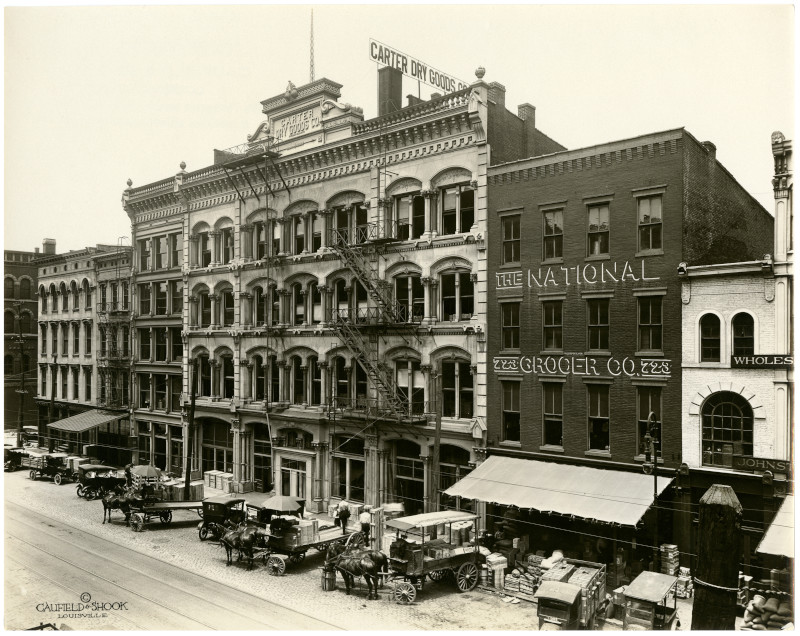
“This is a great example of a photo that shows buildings that still stand today in their original context. The large building in the center is the Carter Dry Goods which is now the Kentucky Science Center. If you go back and look at the building today, which was built in 1878, you can still see the name Carter Dry Goods at the top of the façade.”
Opening of Municipal Bridge, Jeffersonville, Indiana, 1929.
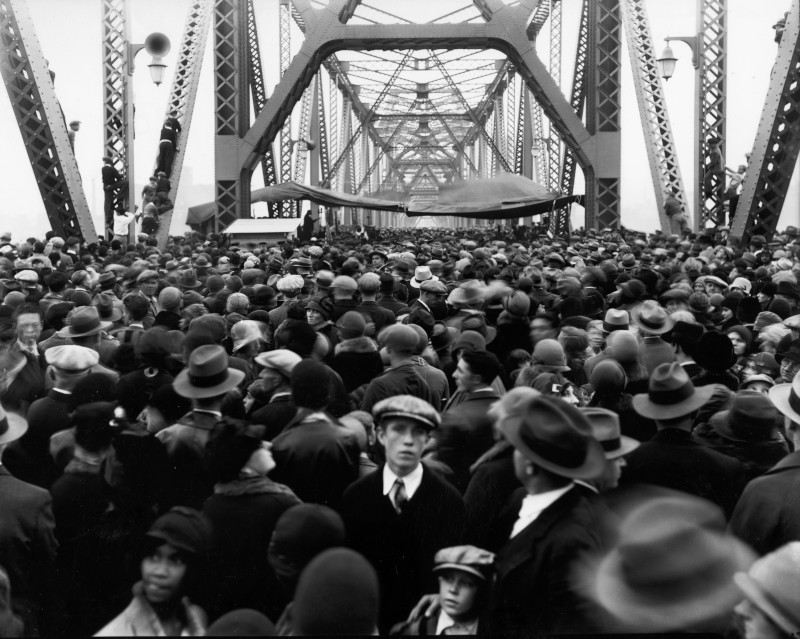
“Here is another photograph of a familiar Louisville landmark, the Second Street Bridge, on its opening day. The was the first bridge offering motor vehicle connection between Louisville and Southern Indiana, but here we see it filled with hundreds of pedestrians. I love this photograph particularly for the young man looking at the camera in a sea of people facing the other direction.”
Cherokee Park, Louisville, Kentucky, circa 1927.
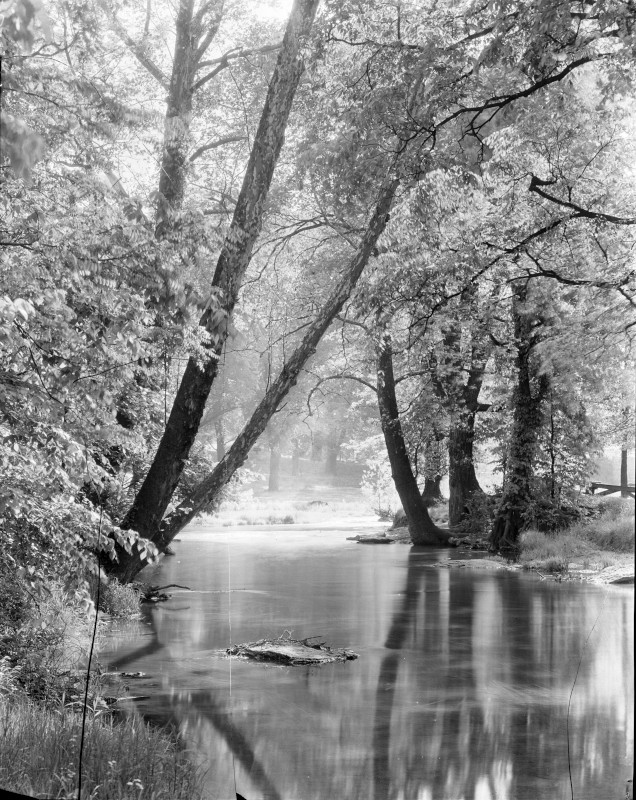
“William Bowers, who joined the company as a third partner in 1907, took a lot of photographs around the parks of Louisville for the Caufield and Shook stock files that they would sell in their studio for people to decorate their homes with. These stock files were a very big source of their income and were located on the second floor of their studio and therefore were spared from damage from the 1937 flood. As a result, we have those original prints today in the collection.”
Transport Workers Union demonstration, Louisville, Kentucky, 1939.

“I love how this photo shows that Louisvillians were fighting for their rights back in 1939, just as we still are today. It’s a great shot of citizens demanding rights, better pay and conditions by protesting and holding signs.”
Hippodrome, Louisville, Kentucky, 1938.
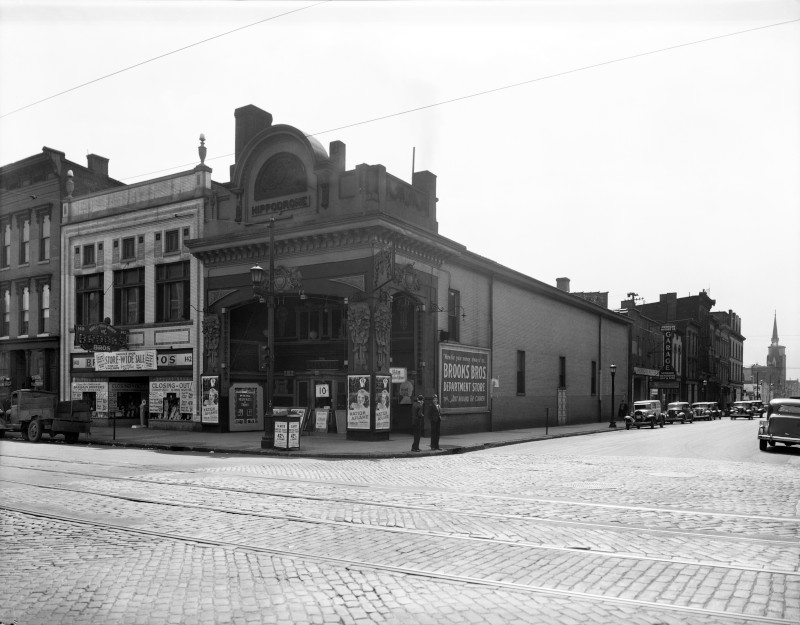
“This photo is a great example of a view of downtown that no longer exists. These buildings are gone, replaced with a one-story building and a parking lot, but the church in the right-hand background is still present. Photos like this raise questions about why certain buildings and blocks were demolished and others were not, sparking an examination of the urban renewal that began here in the 1960s and ’70s. This corner constitutes the western edge of the ‘East Downtown Renewal Area’ that was considered a blighted area and designated for clearing.”
Puppies with bananas at Denunzio’s Fruit Market, Louisville, Kentucky, 1938.
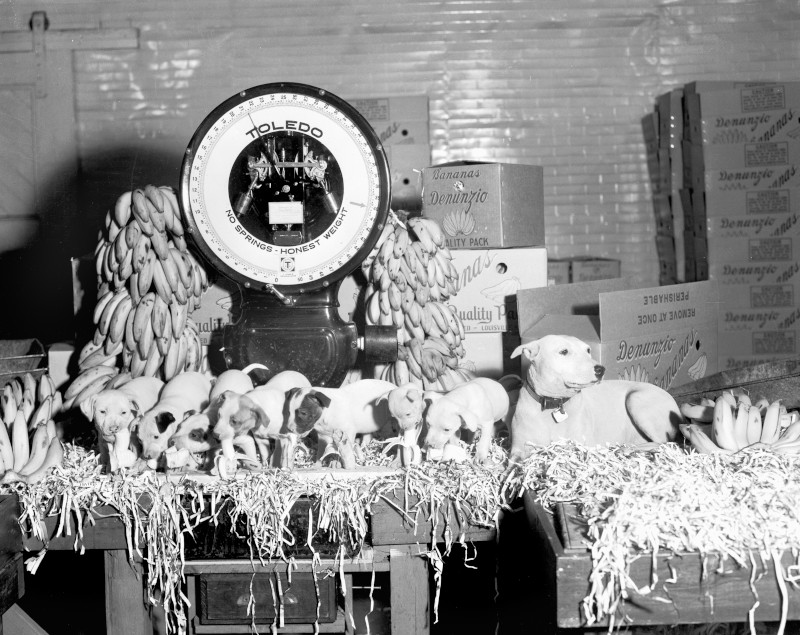
“I’m a dog lover, especially of bully breeds like the ones pictured here. But this adorable photo also leads me to ask how and why this silly photo was taken. Was Caufield & Shook hired to create an advertisement for this fruit market? Were they the shop owner’s dogs? I love quirky photos like this.”
Bicyclists in front of Young’s Pharmacy, Louisville, Kentucky, 1938.
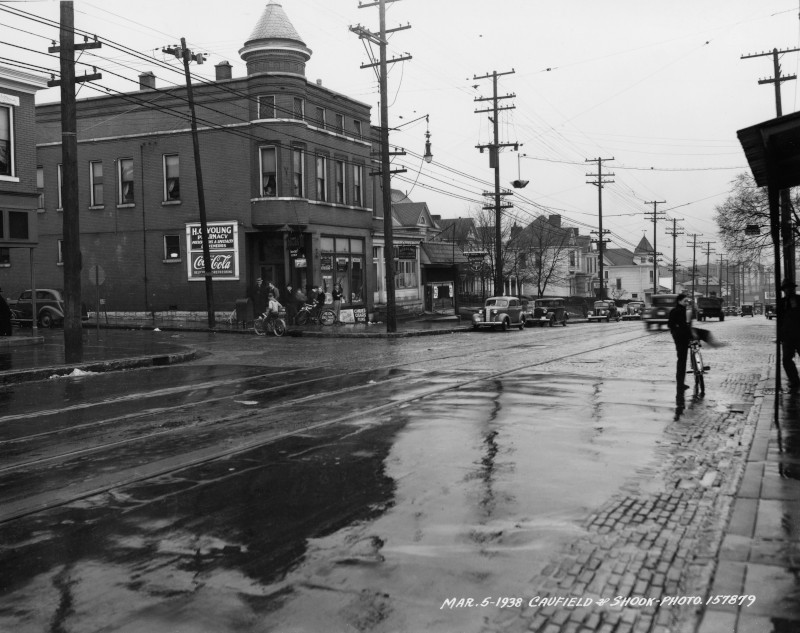
“This is an example of a photo that shows a building that still stands today and might be very recognizable to people who frequent Frankfort Avenue. With photos like this, I like to open Street View on Google Maps to match the same point of view of the old photograph and compare today’s view to what is seen in the photo. Today, there is still a ghost sign (a faded, painted ad on a building) of the name of pharmacy on the building. I also love this shot for the wet street reflecting light and the moment of the boy getting off his bicycle – it’s very atmospheric.”
Young’s Pharmacy interior, Louisville, Kentucky, 1927.
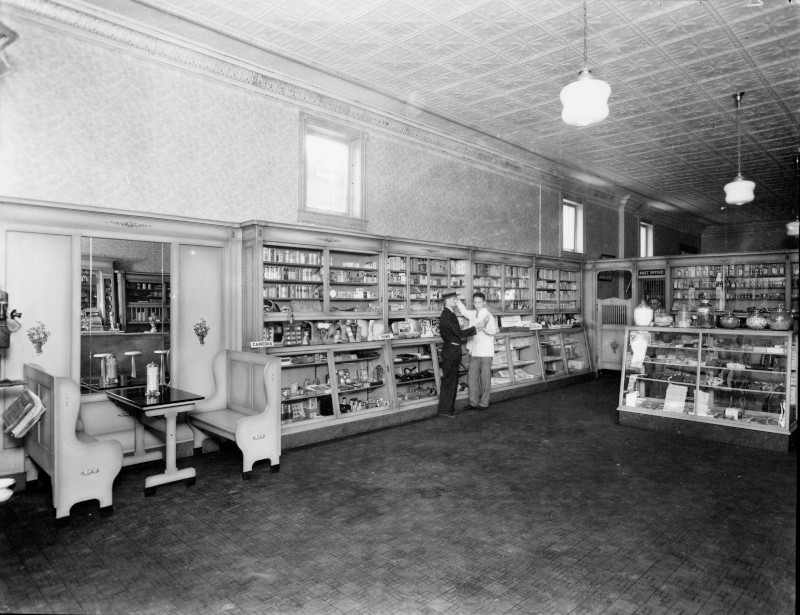
“This is an interior view of the pharmacy photographed above, but 11 years prior. There are far fewer interior views of old businesses and buildings than there are exterior shots, and I love seeing what these sorts of stores looked like and what types of wares they were selling.”
Children in Halloween costumes, 1928.
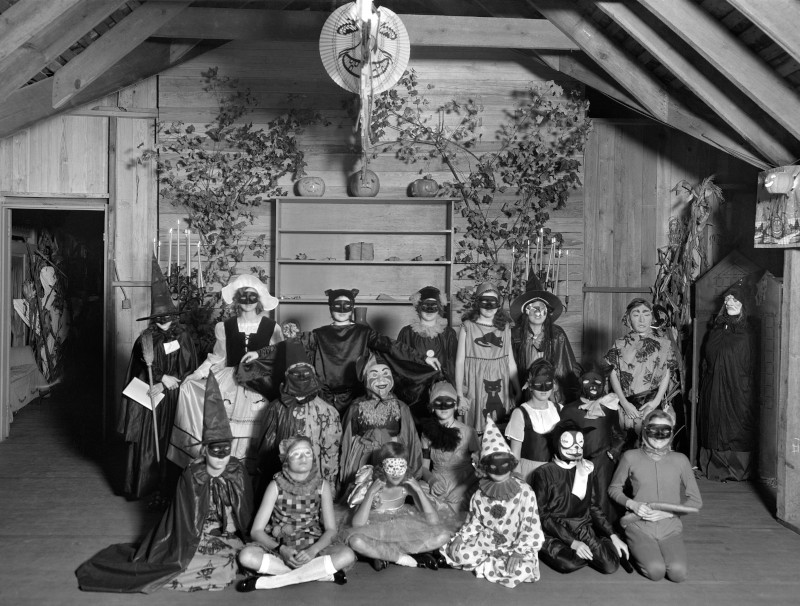
“I chose this photo really just because I’m a collector of vintage Halloween decorations and I just love zooming in and examining the details of the children’s beautiful costumes.”
If you are interested in having your students interact with primary source material, schedule an instruction session for your class.
To see what else lives in UofL’s archives, explore more collections.



